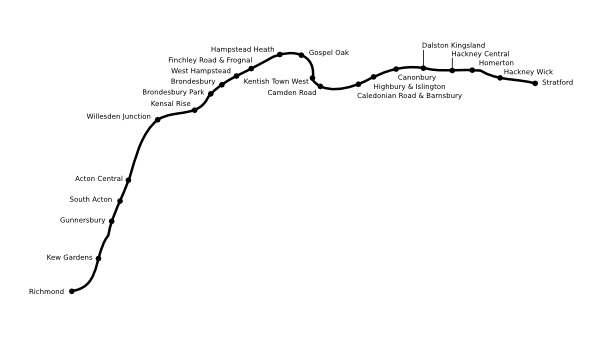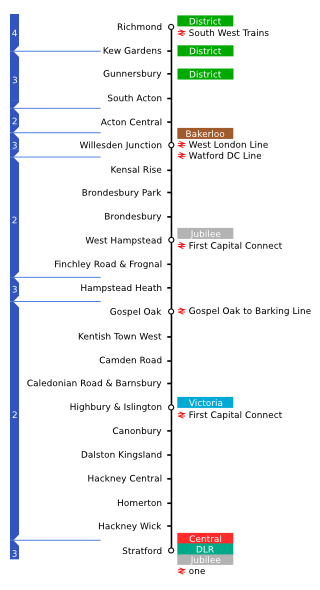North London Line
The North London Line is a railway line through northern London. It carries passenger trains operated by Silverlink and goods trains. It was sometimes referred to as the North London Link and also considered (confusingly) to be one of the North London Lines along with the Barking & Gospel Oak line with which it connects at Gospel Oak.
The line is perhaps best envisaged as a 'horse-shoe' looping across north London, bypassing central London. It crosses many of the arterial routes radiating from central London, offering a faster and more convenient way of traversing north London than travelling into the centre and out again.
Silverlink currently run 4 trains an hour in each direction during off peak hours, with additional services during the peaks, including a few to Clapham Junction over the West London Line.
Contents
History
The North London Line was formed from an amalgamation of two lines:
- The western section of the line, the North London Railway, ran from Richmond to Broad Street (near Liverpool Street) via Dalston, and opened in 1869. The NLR had a spur line from Dalston linking it with Stratford, which since 1944 had been used by goods trains only.
- The eastern section was part of the line between North Woolwich and Tottenham Hale via Stratford. It opened as the Eastern Counties and Thames Junction Railway in 1846 and services at one time ran to Palace Gates (Wood Green) (near Wood Green). This was rerouted to Tottenham in 1963 in the wake of the Beeching Report.
In 1979 a new service, known as the CrossTown LinkLine, commenced between North Woolwich station and Camden Road. At first there were no intermediate stations, with Hackney Wick and Hackney Central, both on the sites of stations closed in the 1940s, opening later, and that at Homerton later still. As the line was not electrified services were provided by diesel multiple unit trains. Concurrent with the commencement of the CrossTown LinkLine, new platforms at West Ham were constructed to permit interchange with the Underground station adjacent.
In the 1980s Broad Street was earmarked for closure and demolition, while the Tottenham Hale–Stratford link and the station at Lea Bridge ceased to be used by regular passenger trains. Thus, the two lines were merged in 1985, initially as the CrossTown LinkLine service detailed above. When Broad Street was closed the line between Dalston and North Woolwich station was electrified on the third-rail system with Broad Street trains diverted to North Woolwich.
In addition to the primary Broad Street-Richmond service there were services that linked Broad Street with Harrow & Wealdstone and Watford Junction on the West Coast Main Line. Most of these were routed via the line between South Hampstead and Camden Road, calling at Primrose Hill, although some travelled via Hampstead Heath and switched to the Watford line at Willesden Junction. By the time that Broad Street closed in 1985 the Watford services operated only in the rush hours, and they were diverted to Liverpool Street by way of a new link in Hackney. However, with trains frequently cancelled, and some timed to arrive at Liverpool Street Station after the start of the working day (plus the evening workings also being timed to not be suitable for office workers), patronage was very low and after a few years they were withdrawn.
In 2000 Anglia Railways (now 'one') started a service between Basingstoke and Ipswich, utilising parts of the North London Line. The service was called London Crosslink and ran up to five times a day at roughly twohourly intervals. The service was fast, calling only at principal stations such as Staines, Feltham, and Brentford. On the North London Line the trains called at Stratford, Highbury & Islington, Camden Road (some services only) and West Hampstead. Unfortunately the service ceased, after just a few years and with uncompetitive journey times and capacity constraints on the North London Line.
It is said that [weasel words]failure was partly due to very little advertising of the service plus the need to fit in with existing services. This resulted in a timetable where services did not operate to an easy to remember clockface pattern, that the journey times were very relaxed (slower than they could have been), that the trains only operated at quieter times of the day - all these being factors which resulted in lower than expected patronage. Some critics have also suggested that the service was unpopular with the railway operators, and that had it been operated differently and marketed with greater enthusiasm it would have been more successful. Many of those passengers who did use the service very much appreciated being able to travel through London without needing to change trains.
In December 2006, the line between Stratford and North Woolwich was permanently closed, to make a way for a Docklands Light Railway extension from Canning Town to Stratford International. The section south of Canning Town is largely duplicated by the DLR's new King George V branch.
Map & Configuration
Only Richmond and Kew Gardens stations, at the western end of the line, are south of the River Thames; the river crossing is made by Kew Railway Bridge on tracks which are shared with the London Underground District Line. The location of the eastern extremity has varied over the years. Between 1944 and 1985 it was at Broad Street station, then it switched to North Woolwich, now it is at Stratford.
There is now only one tunnel on the line, the Hampstead Heath tunnel, under Hampstead between Finchley Road & Frognal and Hampstead Heath. The former North Woolwich branch also featured a tunnel, the Connaught Tunnel, which was under the docks between Custom House and Silvertown. There are long-term proposals for this tunnel to be reused in the projected Crossrail railway line.
The line is electrified using the third-rail system from Richmond to Acton Central, Camden Road to Dalston Kingsland (southern pair of lines only) and Dalston Kingsland to North Woolwich. Overhead lines are used from Acton Central to Camden Road, Camden Road to Dalston Kingsland (freight lines only) and Dalston Kingsland to Channelsea Junctions (link to Temple Mills, Stratford High Level and Liverpool Street). Class 313 dual voltage electric trains compatible with both systems are used.
Nowadays the line is dual-track throughout; however, the former North Woolwich branch included a section of single track between the Connaught Tunnel and North Woolwich station.
At one time there was a second pair of tracks between Camden Road and Broad Street, with the (present day) route to Stratford splitting just before the route turned south towards Broad Street. There was also a connection so that trains could travel between Broad Street Station and Stratford. Nowadays the four tracks still merge (back into two) just before the disused spur to Broad Street.
The AC electrification of the eastern part of the North London Line uses the previously unelectrified northern pair of tracks, which were also partially singled at the same time. Between Canonbury and Highbury & Islington there is a line which links in with Finsbury Park on the East Coast Main Line. This used to carry passenger trains to / from various North London stations (such as Edgware, Alexandra Palace, High Barnet, Welwyn Garden City and others) over part of the North London Line to Broad Street Station, however since the opening of the Great Northern Electrics suburban electrification which in the 1970's saw trains being diverted into Moorgate (deep level tube) and Kings Cross (suburban) this link has only been used for freight trains. It too was singled concurrent with the AC electrification of the eastern part of the North London Line.
Lost stations
A number of stations on the line been closed. These include:
Broad Street spur
A spur line from the junction at Dalston led into the line's central terminus at Broad Street:
Much of this stretch of line will be utilised in the extension of the East London Line, with the stations at Haggerston and Dalston Junction rebuilt.
North Woolwich branch
On 10 December 2006, the line between Stratford and North Woolwich was closed, to make way for a future Docklands Light Railway extension to Stratford International. This will take over the section of the line between Stratford and Canning Town, with other parts of the line earmarked for the future Crossrail development.
- West Ham station
- Canning Town station
- Custom House station
- Silvertown station
- North Woolwich station
All but the last two stations are still open, served by the DLR and/or the Jubilee Line. The DLR's King George V branch (opened 2006) runs parallel to the North Woolwich branch, and serves much the same area.
Poor service
The North London Line is regarded by frequent travellers as offering a poor service, with extremely congested trains and an unreliable service with some trains cancelled shortly before they are due to arrive. A recent London Assembly report described the current service as "shabby, unreliable, unsafe and overcrowded." [1]
It is hoped that the imminent transfer of the service to Transport for London (TfL) will improve the quality of the service. [2]
Future
Confirmed
- From November 2007, management of the North London Line will transfer to TfL, becoming part of the London Overground network. As well as promises of investment in infrastructure and more frequent services, TfL management will bring the North London Line under the Oystercard ticketing system.[1]
- By June 2010, the extended East London Line will connect to the NLL at the reopened Dalston Junction station where passengers will be able to interchange for services from Dalston Kingsland.[2]
Unconfirmed
- The service may be extended to Kingston, calling at all intermediate stations. This would see services on the Kingston Loop Line between Kingston and Richmond increased to four trains per hour.
- Maiden Lane station may be reopened by Camden Council.[3]
Trivia
- The line is notable for being the only National Rail route shown on the London Underground map. It was added in 1977 following pressure from campaigners for integrated transport policies. Tube maps have also shown the Thameslink line from Kentish Town to London Bridge and Elephant & Castle, and the Waterloo & City Line prior to its transfer to London Underground. The Northern City Line from Moorgate to Finsbury Park also sometimes appears on maps - this used to be part of the Northern Line but is now operated by First Capital Connect.
- The North Cross Route, one side of the Ringway 1 inner ring road, would have paralleled the North London Line.
References
- ↑ Transport for London - Introducing 'London Overground'
- ↑ Transport for London - East London Railway project status'
- ↑ King's Cross Development plan


